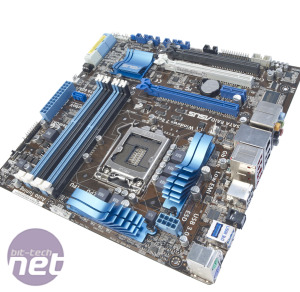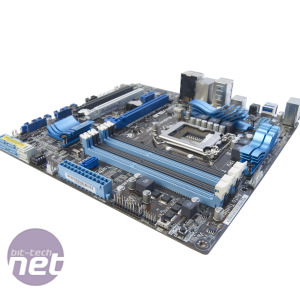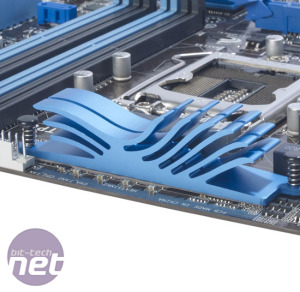
Performance Analysis
The P8P67-M Pro’s stock-speed performance in our Media Benchmarks was solid; its overall score of 1,928 was the second best we’ve seen, putting it only behind the Asus Sabertooth P67. Its video encoding score of 2,784 was particularly superb, beating every other P67 motherboard we’ve tested.Unfortunately, the board couldn’t keep up with the other P67 boards we’ve seen when gaming; its minimum frame rate of 70fps was the slowest result we’ve recorded. SATA speeds were a different matter, however – the average 356MB/sec read speed of its P67-based SATA 6Gbps ports was right at the top of the table.
Overclocking the P8P67-M Pro was interesting, as its EFI is sparse compared with those of other P67-based Asus motherboards we've tested. Only two of the usual four CPU voltage options were present, and vcore adjustments have to be made with offset as opposed to absolute values, which is annoying.
This didn’t hold the P8P67-M Pro back, though, as it achieved an amazing overclock of 5.1GHz, which is the highest stable clock speed we’ve seen from our Intel Core i5-2500K. What’s more, this overclock required a vcore of just 1.34V and a VCCIO of 1.1V; most other boards have required a Vcore of at least 1.4V to push our test CPU anywhere near 5GHz.
At 5.1GHz, the P8P67-M Pro cut through our Media Benchmarks like a lightsaber through butter, racking up an overall score of 2,744. This is the highest result we’ve seen from an overclocked P67 motherboard, although it was admittedly only around 50 points better than the overclocked score of the MSI P67A-GD53. Gaming performance also increased significantly, but unfortunately its minimum frame rate of 75fps was still a way behind the full-size ATX boards we’ve seen.
It wasn’t all good news for the P8P67-M Pro, however. For example, the tiny VRM and chipset heatsink became extremely hot when the board was overclocked, even with an extra 120mm fan blowing air across the board. As such, you're advised to make sure there’s plenty of airflow running through your case if you’re considering the P8P67-M Pro as a possible purchase for overclocking.
Conclusion
The P8P67-M Pro is undoubtedly an epic little overclocker, but overclocking potential is only one of the criteria by which we rate motherboards, and the P8P67-M Pro suffers when it comes to gaming performance, and its on-board heatsinks get worryingly hot.As a result, we can only recommend the P8P67-M Pro if you specifically need a micro-ATX LGA1155 motherboard and know you won’t be overclocking it too heavily. It may be able to handle an impressive overclock, but this clearly stresses the heatsinks and it's unlikely to be able to deal with a large overclock for a serious length of time. If, however, you can fit a full-size ATX motherboard in your build, then you’d be miles better off with the MSI P67A-GD53 (B3), which is not only cheaper but also has more features and runs cooler.
-
Value21 / 25
-
Features18 / 30
-
Speed40 / 45


MSI MPG Velox 100R Chassis Review
October 14 2021 | 15:04












Want to comment? Please log in.